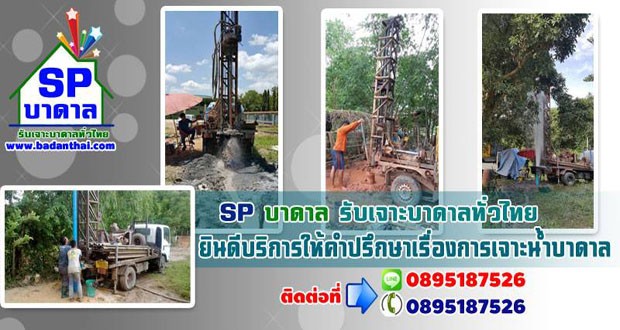
1) พื้นที่ใดมีลักษณะเป็นทุ่งราบ ถามนักธรณีวิทยาได้ความรู้ว่า พื้นที่นั้นรองรับด้วยแหล่งกรวด ทราย หนาเกินกว่า 25 เมตร จากผิวดินลงไป ตรวจดูบ่อชาวบ้านถ้ามีบ่อน้ำใช้ตลอดปี ระดับน้ำในบ่อไม่ลึกมาก และกรวดทรายที่ชาวบ้านขุดขึ้นมามีลักษณะกลมมน พื้นที่นั้นๆ มักจะเป็นแหล่งน้ำ จะเลือกเจาะที่ไหนก็ได้
2) พื้นที่ใดมีลักษณะเหมือนในข้อ 1 แต่กรวดทรายที่ชาวบ้านขุดขึ้นมาไม่กลมมน แต่มีเหลี่ยม มีแง่หรือมุม มีดินเหนียวขาว ๆ ปนอยู่ทั่วไป ลักษณะท้องที่นั้น มักจะไม่มีแหล่งน้ำ ทุกจุดที่เจาะ การเลือกที่เจาะควรปรึกษานักวิชาการน้ำบาดาลดีกว่าที่จะเลือกเอง
3) พื้นที่ใดเป็นทุ่งราบหรือหุบเขา มีแม่น้ำลำธารไหลผ่าน ตัวน้ำคดเคี้ยวไปมา และมีหาดทรายกว้างขวาง ฤดูฝนมักจะมีน้ำล้นฝั่ง ฤดูแล้งมีน้ำไหล ท้องที่นั้นจะเป็นแหล่งน้ำบาดาลอย่างดี จะเจาะตรงไหนก็ได้ไม่จำเป็นต้องไปจ้างคนทรงให้มานั่งทางในชี้จุดเจาะให้
4) พื้นที่ใดเป็นคุ้งน้ำ ควรเลือกเจาะบริเวณคุ้งน้ำด้านที่มีหาดทราย ด้านตรงข้ามซึ่งมีตลิ่งชันและน้ำเซาะไม่ควรเจาะ
5) ท้องที่ใดมีลักษณะเป็นทุ่งราบกว้างขวางริมทะเล จะเจาะที่ไหนก็ได้น้ำบาดาล แต่อย่าเจาะให้ลึกเกินไป อาจได้น้ำเค็ม
6) พื้นที่ใดมีลักษณะเป็นที่ราบลานเทขั้นบันไดหลายชั้น ควรเลือกเจาะในบริเวณที่อยู่ระดับที่ต่ำที่สุด ที่ราบอยู่ระดับสูงๆ ถึงแม้จะมีน้ำก็จะมีระดับลึก
7) โดยปกติจะมีชั้นดินเหนียวสลับอยู่ในชั้นกรวดทราย การขุดบ่อในที่ใด ถ้าพบดินเหนียวไม่มีน้ำก็อย่าเพิ่งหมดหวัง ถ้ามีความสามารถจะขุดลึกลงไปอีก ก็จะถึงชั้นทรายมีน้ำ
8) บ่อเจาะ หรือขุด ควรอยู่ห่างจากแหล่งน้ำโสโครก เช่น ส้วม หรือ ท่อระบายน้ำ ให้มาก ที่สุดเท่าที่จะมากได้ กระทรวงสาธารณสุขสหรัฐอเมริกาแนะนำว่า บ่อขุดควรอยู่ห่างจากส้วมไม่น้อยกว่า 50 ฟุต
9) พื้นที่ใดเป็นทุ่งราบแล้ง แต่มีต้นไม้ขึ้นเขียวชอุ่มเป็นแนวยาว เป็นตอน ๆ ตลอดปี แสดงว่าบริเวณนั้นมีแหล่งน้ำบาดาล ซึ่งอาจจะอยู่ในบริเวณร่องน้ำเก่า ๆ ก็ได้ ถ้าจะเจาะน้ำบาดาลบริเวณที่มี ป่าไม้ก็จะได้ผล
10) พื้นที่ใดเป็นหินไม่ว่าจะเป็นแบบโผล่ให้เห็นบนผิวดิน หรือฝั่งตื้นๆ อยู่ใต้ผิวดิน การเลือกเจาะน้ำบาดาลในบริเวณนั้นควรจะให้นักวิชาการเลือกให้ หรือให้คำแนะนำ เพราะแหล่งน้ำบาดาลในหินมิได้มีอยู่ทั่ว ๆ ไปเหมือนในกรวดทราย การเลือกจุดเจาะต้องอาศัยข้อมูลทางธรณีวิทยาเป็นหลัก แต่ถ้าจำเป็นต้องเลือกเองจริง ๆ ก็ควรจะเลือกในบริเวณต่ำ ๆ ยิ่งถ้ามีที่เจาะในที่ซึ่งเป็นหุบแนวยาว ๆ ด้วย ก็ยิ่งมีโอกาสได้น้ำ
11) พื้นที่ที่เป็นแหล่งน้ำเค็ม หรือแหล่งเกลือ ดังเช่น ในที่ราบตอนกลางของภาคตะวันออกเฉียงเหนือ ควรจะเลือกที่เจาะในบริเวณที่เป็นเนินสูง ๆ มีป่าหรือพุ่มไม้ทั่วไป เพราะอาจมีโอกาสได้น้ำจืด
12) พื้นที่ซึ่งเป็นภูเขา มีหินแข็งโผล่ให้เห็นทั่วไป ชั้นหินก็เอียงเทลงไปทางเชิงเขา ไม่ควรอย่างยิ่งที่จะเจาะน้ำบาดาลในบริเวณนั้น แต่ถ้าต้องการน้ำจริงๆ ก็ควรเลื่อนที่เจาะลงไปทางเชิงเขาอาจจะได้น้ำ และน้ำอาจจะพุ
Drilling artesian wells
1) Which area is characterized as a plain Ask a geologist to know that The area is supported by gravel, sand, more than 25 meters thick from the soil surface. Inspect the villagers' wells if they are available year-round. The water level in the well is not very deep. And the sand gravel that the villagers dug up has a round shape that area is often a source of water. Can choose to drill anywhere
2) Any area that looks the same as in number 1, but the sand gravel dug up by the villagers is not round, but is square, has facets or corners, is mixed with white clay. Often there is no water source every puncture point choosing a drill should consult a groundwater scholar rather than choosing it yourself.
3) Which area is a plain or a valley? There are rivers and streams flowing through. The water zigzag and has a wide sandy beach The rainy season tends to overflow the banks. The dry season has flowing water. That area will be a good source of groundwater. You can drill anywhere, you don't need to hire a medium to sit inside and point out the piercing point.
4) What area is a watershed? Should choose to drill in the bend on the side that has a sandy beach. The opposite side, where there is a bank and erosion, should not penetrate.
5) What area looks like a wide plain by the sea? Will drill anywhere groundwater. But don't delve too deeply. Maybe salt water
6) Which area is characterized as a flat terrace with multiple steps? Should choose to drill in the area that is at the lowest level. The plains are high. Even with water, there is a depth.
7) Usually there is an alternating clay layer in the sand gravel layer. Where to dig a well If clay soil is found without water, do not despair. If you have the ability to dig deeper will reach a layer of sand with water
8) Wells or digs should be as far away from sewage sources as toilets or sewers as possible. The United States Department of Health recommends that The pit should be at least 50 feet from the toilet.
9) Which area is a dry plain? But there are evergreen trees growing in sections throughout the year, indicating that the area has groundwater resources. Which may be in the old channel Forests will work.
10) Any area that is rocky, whether it is outcropped or visible on the soil surface. Or shallow shore under the surface The selection of groundwater drilling in that area should be given to academics. or give advice because groundwater in rocks is not as common as in gravel The selection of drilling sites depends primarily on geological data. But if you really have to choose yourself, it should be in a low area. If there is a hole in the long ravine as well, the more chances of getting water.
11) Areas that are salt water sources or salt sources such as in the central plains of the Northeast Should choose to drill in hilly areas with forests or shrubs in general. Because there may be a chance to get fresh water
12) mountainous area There are solid rock outcrops everywhere. The rock strata was slanted and poured down towards the foot of the mountain. It is strongly advised not to drill groundwater in that area. But if you really want water It should slide the drill-down to the foot of the mountain may get water. And the water may spring
钻自流井
1) 哪个区域的特征是平原 问地质学家知道该区域由砾石、沙子支撑,距土壤表面的厚度超过 25 米。检查村民的水井是否常年可用。井里的水位不是很深。村民挖出的沙砾呈圆形,这片区域往往是水源。可以选择在任何地方钻孔
2) 任何看起来和1号一样的地方,但是村民挖出来的沙砾不是圆形的,而是方形的,有棱角,有棱角,夹杂着白土。往往没有水源,每个穿刺点的选择都应该咨询地下水学者,而不是自己选择。
3)哪个地区是平原或山谷?有河流和溪流流过。水曲折,有宽阔的沙滩 雨季往往溢出河岸。旱季有流水。该地区将是地下水的良好来源。你可以在任何地方钻孔,你不需要雇一个媒介坐在里面并指出穿孔点。
4) 什么区域是分水岭?应选择在有沙滩一侧的弯道上钻孔。对面有堤岸和侵蚀,不应渗透。
5) 哪个区域看起来像海边的广阔平原?将钻探任何地下水。但不要钻得太深。可能是盐水
6) 哪个区域的特点是多台阶的平坦露台?应选择在最低层的区域钻孔。平原很高。即使有水,也有深度。
7)砂砾石层中通常有交替的粘土层。在哪里挖井 如果发现没有水的粘土,不要绝望。如果你有能力挖得更深,就会到达一层带水的沙子。
8) 井或坑应尽可能远离污水源,如厕所或下水道。美国卫生部建议该坑距马桶至少 50 英尺。
9) 哪个地区是干旱平原?但常绿乔木终年分段生长,说明该地区有地下水资源。这可能在旧频道 Forests 中有效。
10) 任何有岩石的区域,无论是露头的还是在土壤表面可见的。或地表下的浅岸 该地区地下水钻探的选择应交给学术界。或提供建议,因为岩石中的地下水不像砾石中那样常见 钻井地点的选择主要取决于地质数据。但如果真要自己选的话,应该是在低区。如果长长的沟壑上也有一个洞,得到水的机会就越大。
11) 东北中原等有咸水源或盐源的地区一般宜选择在有森林或灌木的丘陵地区钻探。因为可能有机会得到淡水
12)山区到处都有坚固的岩石露头。岩层倾斜,朝着山脚倾泻而下。强烈建议不要在该地区钻探地下水。但是如果你真的想要水它应该将钻头滑到山脚下可能会得到水。水可能会涌出



